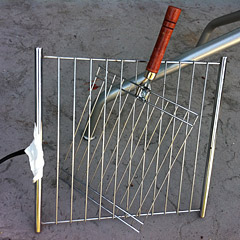Posted: October 31st, 2012 | Author: Nathan | Filed under: field recording, sound design
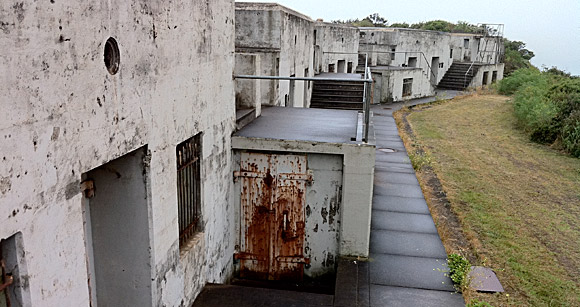
Battery Yates, Fort Baker, Sausalito, California.
Over a year ago, I posted some scraping metal sounds from the steel doors of Fort Baker’s Battery Yates, right at the Golden Gate of the San Francisco Bay. I recently unearthed some metal hits from that same session: They’re heavy, resonant, and the concrete rooms behind them certainly lent the sound some nice air in the low end. (Read the previous installment if you want to learn more about this location and how it was recorded.)
And, since today is Halloween, the original sounds are presented in both their original form and pitched down by an octave for extra heaviness and spookcreeptacularness.
Enjoy the clanky, boomy fun…and happy Halloween!
[soundcloud url=”http://api.soundcloud.com/tracks/65535342″ params=”auto_play=false&show_artwork=false&color=ee0000″ width=”100%” height=”166″ iframe=”true” /]
[MKH 50 microphone into Sound Devices 702]
Tags: creepy, field recording, industrial, metal, resonance, San Francisco, sound effects | No Comments »
Posted: February 20th, 2012 | Author: Nathan | Filed under: field recording, nature recording, sound design
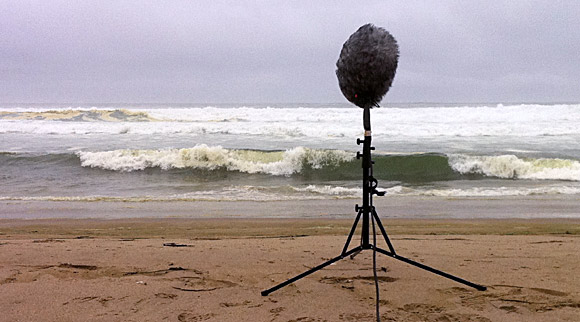
Look carefully: Deep impact zone, short period, wind parallel to the shoreline. Not a good day for recording single waves. So...what is?
It’s easy to get recordings of roaring surf – which can often just sound like constant white noise – but it can be tough to get relatively clean recordings of individual waves. I’ve found that picking a good day and place to record single wave hits are a combination of marine forecasts and location, and that the size of the waves really doesn’t matter.
The only online article I’ve seen that mentions both field recording and marine forecasting has been published by Tim Prebble. In that excellent article, he describes finding gentle-surf days to record his amazing Seal Vocals SFX library. Sometimes finding those small- to moderate-swell days are sometimes the best days to record single wave crashes…but that’s not the only factor.
Single-wave recording conditions are largely defined by a mix of swell, wind, and location.
Swell is due to the large movements of water over great difference; swell is not the same as waves, which are usually wind-driven. Swell is usually forecast based on buoys offshore, and is forecast days in advance. However, I find that 2-day swell forecasts are the most accurate. Swell is defined by wavelength and amplitude, just like audio: Wavelength is is measured in seconds (usually called period), and amplitude (usually called height) is based in feet or meters. Ideally, you want swell with long periods, because that means there’s a greater volume of water moving, but tall swell is also your friend, because that also influences breaking-wave heights at the shore. (Tip: Waves come in “sets” of big and small, between 3 and 8 waves each, depending on if there are multiple wavetrains that are in or out of sync. That means record for far longer than you’d otherwise think in order to get a good range of big vs. small waves over time.)
Getting back to the topic of wind, not all wind is bad (and we all know what wind does to field recordings: huge amounts of badness.) Offshore winds (those that come off of the shore – yes, that is totally confusing!) will might wave faces up longer than they’d be up otherwise, causing a moment of quiet before the wave breaks (or “closes out,” in surf parlance) and a potentially taller wave face. Wind coming onshore (onto the shore from the water) often smears the wave tops and can cause premature toppling…not to mention the fact that the wind will be blowing directly at your microphone capsules. (Tip: You can’t be at the shore without shorebirds, often noisy ones. Bird feeding activity, and therefore noise, may peak before an oncoming storm. Watch the forecast and choose clear weeks with low-pressure days, when it requires more energy to fly, when possible to reduce avian noise. Gulls are complete bastards in this regard!)
Finally, this brings us to location. Some of this is taste: Do you want to record breaking waves against sand, or against rock? Very different sounds will come out of each; bigger crashes will happen on rocks as opposed to sand. But beyond that, know a bit about your location. What direction is the swell and wind coming from, relative to where you’ll be facing? How does the land curve around, creating refraction waves? What is the slant of the land below the shoreline? This last one is especially critical, as the gentler the slope, the bigger the wave. The “impact zone” – where the waves actually break – can be deep or narrow, and a narrower impact zone will generate fewer audible breaking waves at once. Knowing if a beach has a “dumping break” is useful: It makes it terrible to launch from or surf near, but that also means the waves break right at the shoreline, which is far better for audio recording. Just watch out for your gear. (Not a tip, but trivia: Waves always break when the water depth is 1.3x to 1.5x the wave height, as the horizontal energy of the swell gets forced upwards to create breaking-wave heights near shore.)
Never turn your back to the sea. The sea is huge, powerful, indifferent, and above all, unpredictable. Rogue and “sneaker” waves are not legends or myths: They occur regularly, anywhere in the world. Don’t let a recording session end in tragedy.
A final note on technique: If you’re on a beach, angle the mic a bit more downwards than you’d think would be wise, and you’ll get nice sounds of the sand being pulled back as the breaking waves recede back into the ocean. Not always good to have in every recording, but this adds a lot more character. On a beach with fist-sized rocks, this can be especially cool!
I had a recent session at a sandy beach in the Point Reyes National Seashore that exemplified some of the better (but not quite perfect) conditions that I describe above. First, the wind was blowing at 20 knots…but from the opposite direction of the beach I was on, which was backed by hills. That meant delayed wave breaks and being protected from the wind. There was a southerly swell that came right into the dumping-break beach (I can tell the period is averaging 14 seconds by looking at the waveforms of the audio!), so it was all breaking swell and no wind-driven waves. It was a low-pressure day with a long-term clear forecast, and it wasn’t winter, when the masses of migratory birds come through Northern California. Only one swallow’s call made it into the recording.
The recordings aren’t all that dramatic when you consider the breaking waves were only 3-4′ high. But listening to this loud on headphones, eyes closed, I find that the sense of scale is quite exaggerated without an accompanying visual reference…a little Waves LoAir or layering some low-frequency booms can definitely can tip it into cinematically-big breaker territory if desired. However, even in a 90-second clip, there are only three really distinct wave “claps” as the bigger waves close out at the beach.
[Sennheiser MKH 30/50 mid-side stereo pair into Sound Devices 702 recorder]
Tags: field recording, nature, nature recording, ocean, sound design, sound effects, surf, water | 3 Comments »
Posted: October 19th, 2011 | Author: Nathan | Filed under: gear, music, sound design
 There are lots of under-the-radar software toys out there for mangling audio, but one that I have yet to hear anyone really discuss much is Spongefork, created by Ryan Francesconi over a decade ago. It’s been around for a long time, and is intended as a live improvisation instrument. Its incredibly sparse interface belies a lot of sonic mangling possibilities, with multiple sample banks and a live-control XY controller. For $65, it’s a fun toy. (Even the demo fully works, just without the ability to save work.) Heck, I’ve used it so long that I upgraded when I made the move from Mac OS 9 to OS X!
There are lots of under-the-radar software toys out there for mangling audio, but one that I have yet to hear anyone really discuss much is Spongefork, created by Ryan Francesconi over a decade ago. It’s been around for a long time, and is intended as a live improvisation instrument. Its incredibly sparse interface belies a lot of sonic mangling possibilities, with multiple sample banks and a live-control XY controller. For $65, it’s a fun toy. (Even the demo fully works, just without the ability to save work.) Heck, I’ve used it so long that I upgraded when I made the move from Mac OS 9 to OS X!
Here’s a set of live tweaks to some sheet metal hits (recorded when we had a custom heat shield fabricated for our wood stove). In my library, when I see “forked” in a filename, I know it’s gonna get weird…
[soundcloud url=”http://api.soundcloud.com/tracks/25411488″ params=”show_comments=true&auto_play=false&color=ee0000″ width=”100%” height=”81″ ]
| 1 Comment »
Posted: October 13th, 2011 | Author: Nathan | Filed under: found sound objects, sound design
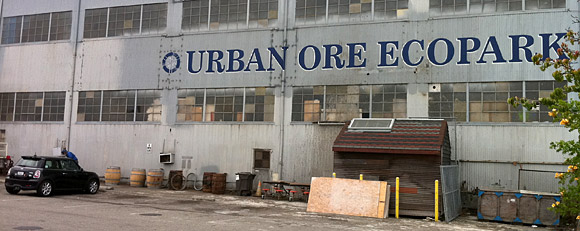
My mecca on a foggy morning: Urban Ore!
I went to the granddaddy of thrift stores recently, so much so that it’s more of a glorified junk store…but oh, what glorious junk. I’m talking about Urban Ore in Berkeley, California. Sometimes I’m self-conscious shopping for things by ear, picking up random things and just listening to them, but at Urban Ore – heck, Berkeley in general – I can ear-shop in peace.
I was in a metallic mood, so I filled a bag with things that squeak, resonate, creak, clank, and sproing. Based on the dronetastic results of striking wire shelving last year, I picked up a few thin-wire metal grills that had sonic promise, among other things that will surely find their way to this blog later this fall and winter.
For the grills, I decided to trot out my much-neglected piezo contact microphones. The resonant notes were so subtle that it seemed like the best way to capture the sound at a reasonable volume. I plucked them, struck them, and played them with a cello bow. The magic happened, though, when I realized one was easily played with a bow and the other was not, so I stuck the bowable one inside of the other, and played away, causing both of them to resonate when played appropriately.
The results were like ultra-low-fi bastardizations of stringed instruments played in horror movies, and I just loved the character. The rawness of hearing the actual hairs of the bow on the metal, in my opinion, lends to the eerie charm.
[soundcloud url=”http://api.soundcloud.com/tracks/25407627″ params=”show_comments=true&auto_play=false&color=ee0000″ width=”100%” height=”81″ ]
[Contact microphone into Sound Devices 702 recorder]
Tags: creepy, digital audio, eerie, found object, groaning, horror, metal, resonance, sound design, sound effects | No Comments »
Posted: August 2nd, 2011 | Author: Nathan | Filed under: field recording, sound design
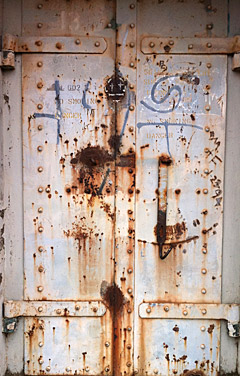
Rusty? Heavy? Covered in graffiti? You KNOW it will sound good.
Many people are unaware that the San Francisco Bay Area was once thoroughly fortified against attacks from the sea. Remnants of this past dot the entrance to the Golden Gate, in the form of bunkers that once housed gun emplacements.
One such installation was Battery Yates at Fort Baker. Located at the best vantage point for southward-facing photos of the Golden Gate Bridge, Battery Yates was meant for nothing other than picking off minesweepers that might try to get through the minefields inside the ‘Gate in wartime…minesweepers, of course, that would never come.
Battery Yates was active from 1905 through 1946. Now, only the U.S. Coast Guard maintains a station at Fort Baker, primarily for saving the lives of boaters and wind/kitesurfers. Now Battery Yates is a tourist attraction, is fun to scramble on and around…and, in swords to ploughshares style, is also a great source for cool sounds!
Each of the gun emplacements has four lockers, each sealed with a massive steel door. Some doors have outer latches that have been left to swing freely in favor of just welding the doors shut. These latches, rusted by more than 60 years of salty mist, are quite expressive when swung, manipulated, and otherwise mishandled. The perfectly square concrete rooms behind these doors caused them to have a lot of low end and resonance.
I decided to try my luck with recording some groaning metal effects on these doors, despite the fact that:
- I only had some time before work one weekday, which meant that…
- I could only record during rush hour, made worse by the fact that…
- The Golden Gate Bridge is only 1/8 of a mile away, plainly visible from the recording site.
All this meant lots of background traffic noise. I mitigated these risks by using a hypercardioid microphone for off-axis rejection of sound (a shotgun would have been a better choice in terms of pattern, but I just loved the sound of my MKH-50 too much to not use it), careful placement of the mic relative to the bridge (making sure that either the mic element faced away from the bridge or a thick concrete wall blocked line of sight), and the judicious use of the Denoiser plugin from iZotope RX. And, for effects like these, the small-condenser-mic proximity effect only helps!
The result came out pretty well, all things considered…although the editing in today’s post is pretty sloppy, so apologies for that. Everything was recorded at 24-bit, 192-kHz, as best befits complex groaning metal sounds, since pitching this stuff down can yield pure sound-design gold. I recorded even more massive metal hits from this session, which may be a topic for a separate post… (And until then, you can hear yet more heavy metal hits/impacts here, here, and here.)
[soundcloud url=”http://api.soundcloud.com/tracks/20003445″ params=”show_comments=true&auto_play=false&color=ee0000″ width=”100%” height=”81″ ]
[MKH 50 microphone into Sound Devices 702]
Tags: field recording, groaning, industrial, metal, noise reduction, resonance, San Francisco, sound design, sound effects, urban | 4 Comments »
Posted: July 28th, 2011 | Author: Nathan | Filed under: found sound objects, sound design

Pumps lift me out of the dumps.
This thread on Social Sound Design made me start thinking about all the manual pumps I had in my shed: One hand sprayer for my fruit trees, one for cleaning off my kayaks with fresh water, and another for bilging out my kayak in case I get water in my cockpit.
I gathered these all together and did a short recording session. As is usual, the proximity effect of closely-placed small-condenser mics were far too bassy, so I went back to my favorite solution for up-close foley and effects recording: The large-condenser mic.
Today’s post is just a small smattering of these sounds. Depending on which pump type it is, they range from sounding silly to serious, low-tech to high-tech, smooth to rattly. These sessions were more exploratory than looking for library-quality; the more rattle-filled pumps probably won’t be as useful as the smoother-action ones. The Bilgemaster hand pump was the cleanest-sounding of them all, with basically no moving parts except the plunger and a small rubber valve. But, the pressure sprayers have pressure release valves on top which can be most useful for air release or hissing sounds!
[soundcloud url=”http://api.soundcloud.com/tracks/18715196″ params=”show_comments=true&auto_play=false&color=ee0000″ width=”100%” height=”81″ ]
[Røde NT1-A into Sound Devices 702]
| No Comments »
Posted: July 6th, 2011 | Author: Nathan | Filed under: gear, music, sound design, synthesis
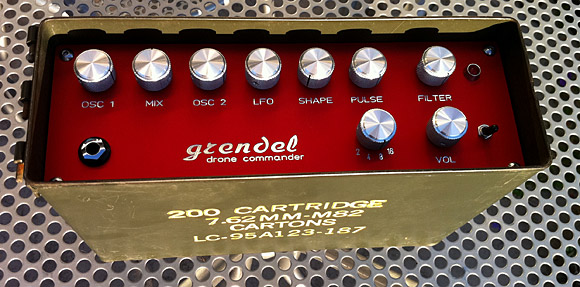
Of COURSE I had to get it in red.
Hand-built one at a time by Eric Archer, the Grendel Drone Commander is a two-oscillator synth built inside of a metal surplus ammo box. Its apparent simplicity belies its sonic complexity. I’m still feeling my way around the thing, but I wanted to post an example of what it makes possible. (Next step: Play with CV control!)
This heavy, drone-y, smeary track was created using only the Grendel Drone Commander, recorded live thee times, each on a different track, in Logic Pro (with a few plug-ins as well).
[soundcloud url=”http://api.soundcloud.com/tracks/18374428″ params=”show_comments=true&auto_play=false&color=ee0000″ width=”100%” height=”81″ ]
| 7 Comments »
Posted: June 9th, 2011 | Author: Nathan | Filed under: found sound objects, sound design

The bottom reads, "WARNING: Beware Unauthorized Personnel." How true.
My downstair work neighbors are an art collective, and all sorts of weird things show up in our lobby from time to time. One that caught my eye was a vintage adding machine. It sat in our lobby for weeks, unclaimed and unmoved (the thing is about 20lbs, despite being the size of a lunchbox), so I decided to borrow it and see what sounds I could get out of it.
It’s in amazing shape for its age. There is a panel that is removable, ostensibly for where paper tape or imprinted ribbon would come out; removing this panel let the inner mechanisms be heard more clearly.
Having close-miked small objects many times before, I guessed that this wasn’t a job for my usual small-condenser hypercardioid mics. The result would be too bass-heavy, sounding “out of scale.” If the sounds were going to be repurposed for, say, the mechanisms of a heavy doorway or industrial machine, the low frequencies would be deepened with downward pitch-shifting anyway. I wound up using a large condenser mic, since I was going for brightness, detail, and clarity.
Here’s a compilation of some of the sounds it generated, stitched together from the two or three dozen discrete sounds I culled from it.
[soundcloud url=”http://api.soundcloud.com/tracks/16583852″ params=”show_comments=true&auto_play=false&color=ee0000″ width=”100%” height=”81″ ]
[Røde NT1A microphone into Sound Devices 702 recorder]
| 2 Comments »
Posted: May 12th, 2011 | Author: Nathan | Filed under: field recording, found sound objects, sound design
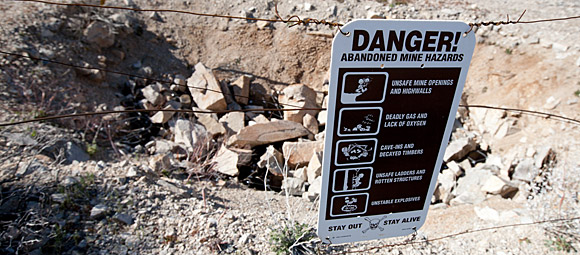
Eton Mine, Lucky Boy Trail, Joshua Tree National Park, California, USA.
[One in a series of posts from my spring 2011 trip to the southern California desert.]
Joshua Tree National Park is beautiful, but much of its history (prior to being designated a National Park) has scarred and pockmarked its landscape. In the Gold Rush, the Joshua Tree hinterlands held some of the most productive mines in California until well into the 1900’s. These mines were big, sprawling, and deep. To my knowledge, no Balrogs were released as a result. But that would explain a lot about Golden State politics.
We hiked on some lesser-traveled trails and found an acre of land with no fewer than five vertical holes in the ground: Mine shafts. They were all wired off and had metal grates over them. One in particular, the Eton Mine on the Lucky Boy trail, had warning signs on the wire fence surrounding it.
It was quite windy that day, and I just knew I had to get the creaking, squeaking sounds of this battered sign on the rusty wire. It took me a surprisingly long time to figure out how to protect my handheld recorder from the wind, but ultimately I decided to use my body as a shield and then stick it under my microfleece hoody. (I had the OEM fuzzy windscreen on it, which is one of the most useless strips of fabric I’ve ever seen, er, heard.) I just hoped that my body protected it from the 25+ mph wind gusts and that the fabric wouldn’t dampen the high frequencies too badly…and because of the sound, I had high-frequency content to burn.
With some judicious noise reduction in post – subtle, as always, gives the best result – it didn’t come out too shabby, considering the horrible recording conditions and super-no-budget wind blocking techniques!
[soundcloud url=”http://api.soundcloud.com/tracks/15163504″ params=”show_comments=true&auto_play=false&color=ee0000″ width=”100%” height=”81″ ]
[Sony PCM-D50 recorder, capsules at 120°]
Tags: creepy, desert, digital audio, eerie, field recording, found object, industrial, joshua tree, metal, resonance, sound design, sound effects, travel | 1 Comment »
Posted: May 4th, 2011 | Author: Nathan | Filed under: field recording, found sound objects, sound design

"Ol' Wheezy" the Water Spigot, as we called him, at our campground in the desert.
[One in a series of posts from my spring 2011 trip to the southern California desert.]
Joshua Tree National Park is in the Mojave Desert. It’s dry. Only two campgrounds in the entire park have running water of any kind. Bad weather on the coast of California caused us to decide to stay in the desert at the tail end of a week’s vacation, so we were lucky to just show up at Joshua Tree and grab a spot at one of these prime campgrounds.
I camp a lot, all over the place, but I had never seen a water spigot quite like the one near our site. It was like the wet dream of a post-apocalytpic film production designer: Big, industrial, heavy, and red. If a common water pump could be bad ass, this one could.
Anyway, the draw-up of water sounded really neat, so I whipped out the ol’ handheld recorder and took some samples on our last morning there. It reminded me a bit of the sound of EVE coming out of her landing ship’s tube from the film WALL•E.
In developed campgrounds, you need to be up really early to avoid noise from fellow campers. No wonder I like backpacking so much…
[soundcloud url=”http://api.soundcloud.com/tracks/13996448″ params=”show_comments=true&auto_play=false&color=ee0000″ width=”100%” height=”81″ ]
[Sony PCM-D50 recorder, capsules at 120°]
Tags: desert, digital audio, field recording, industrial, joshua tree, machine, sound design, sound effects, travel, whoosh | 6 Comments »


 There are lots of under-the-radar software toys out there for mangling audio, but one that I have yet to hear anyone really discuss much is
There are lots of under-the-radar software toys out there for mangling audio, but one that I have yet to hear anyone really discuss much is 
